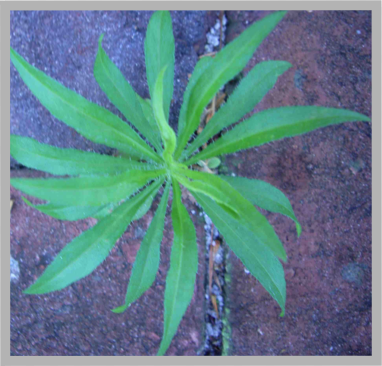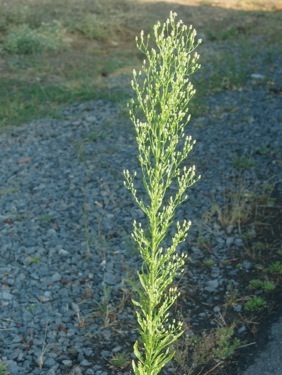Conyza canadensis: Herb, Fire, Food
Conyza will light your fire!
If you’ve ever made fire with a bow and drill — you know, the Boy Scout way — you also know that choosing (or finding) the right materials is absolutely essential for you to create fire. Add to that a medicinal herb and some culinary uses and “horseweed” deserves a place among the useful weeds we should know about.
A native of North America, Conyza canadensis is now found around the world. First listed in North America in 1640 it was in France 13 years later (presumably via seeds on beaver pelts from Canada.) Native Americans used a tea from the leaves to treat dysentery and a tea from the boiled root for menstrual issues. It’s a diuretic and can make you sweat. Horseweed has also been called Fleabane because the leaves put in pets’ beds help to get rid of fleas.
As for food, young leafy seedlings and young leaves can be eaten after boiling, dried leaves can be used as a seasoning with a flavor similar to tarragon. American Indians pulverized the young tops and leaves, eating them raw, similar to using an onion. Per 100g of dry weight the leaves have a small amount of protein and fat, more fiber, good amount of carbohydrates, 8.2 grams ash, 1010 mg of calcium, 280 mg phosphorus, and 2610 mg potassium. An essential oil of Conyza is used to flavor candy, condiments and soda. Fresh leaves contain 0.2 – 0.66% essential oil.
Botanically Conyza canadensis (CON-knee-zah, con-KNEE-zah, con-NEIGH-zah kan-ah-DENSE-iss) means flea from Canada. Conyza comes from the Greek word konops, meaning flea. Pliny used the name for a fleabane, which was put in pet and human beds to keep away fleas.
Conyza canadensis can easily be confused with Conyza sumatrensis and Conyza bonariensis. Conyza canadensis is distinguished by hairless or nearly hairless bracts which lack a red dot at the top but have a brownish inner surface. Conyza sumatrensis has hairy bracts but there are no long hairs near the top of the bracts. Also inner surface of bracts are reddish brown. Conyza bonariensis has densely hairy bracts, and is especially hairy on the stems and around the leaf axils.
While native to North America C. canadensis can be found in The European part of the former USSR, the Caucasus, Western and Eastern Siberia, the Far East, Central Asia, Scandinavia, Middle and Atlantic Europe, the Mediterranean, Asia Minor, Iran, Mongolia, Japan, China, and Australia.
The horseweed is also one of the best, if not the best local material for a drill when making fire with friction. Actually too fragile to be used with a bow, it works very well using the hand method. As you might expect, choose tall straight plants, let dry, remove leaves, and you’re ready. Horsetail is so good often you don’t even need a V-notch to collect a coal, it will produce one in just a depression.
Green Deane’s “Itemized” Plant Profile
IDENTIFICATION: Annual, one to seven feet tall, unbranched except for the flowering stems near top. Central stem ridged, covered with long white hairs; leaves alternate around this stem appearing whorled, similar length, 3-4″ long and ½” across, narrowly lanceolate or oblanceolate, a few teeth toward outer tips, fine white hairs along the edge. Smaller leaves near the blossoms more linear and less likely to have teeth. Many composite blossoms less than 1/8 of an inch across, lasting several weeks.
TIME OF YEAR: Summer to fall
ENVIRONMENT: Prefers full sun and good soil, well watered. But it can grow nearly anywhere, often forms colonies. Drought resistant.
METHOD OF PREPARATION: Dried leaves as a spice, very young leaves and shoots as a green boiled. Stem makes good drill for fire starting.




Thanks for the information about the related species Conyza sumatrensis and Conyza bonariensis. The three fleabanes look remarkably alike to the untrained eye.
Thank you for all the videos that you have made available. I am learning to eat the weeds. I have horseweed but wanted to know if I have the correct one. Are all three types edible? Is the bract a leaf at the top where it flowers? If so, how do you determine which of the 3 varieties you have when they are young and most edible? Is it even necessary to distinguish between them for edibility?
I would stick to only the ones I’ve mentioned as edible.
I’m a little confused. Are Conyza sumatrensis and Conyza bonariensis edible?
I would stick with the main one.
Deane, ” it works very will using the hand method. … Horsetail is so good…” I think these are two typos in the paragraph. Thank you nevertheless for the perennial and best foraging information online.
Hello,
First, a big thank you for your Youtube channel, I watch your videos regularly and it always give me some new ideas about which plants I’m going to harvest and how to prepare them. But I’m a little disappointed that there is no new video since July 🙂
So, these 3 species of Conyza are present in France and I would like to know if these species are edible because you said on the comment above : “I would stick with the main one” but on July 25, 2012 you wrote : “I would stick to only the ones I’ve mentioned as edible.” So, I don’t know what to do 🙁
Moreover, you wrote that young leaves and shoots are eaten boiled but how one can distinguish between these 3 species of Conyza when flowers are not present – in that state, there are no bracts nor flowers that one can use to help identify these species.
So, I think I will stick to using Conyza canadensis only for its stem for making fire with hand-drill method, which – as you wrote – is an excellent drill !
Thanks in advance.
P.S. Sorry for my English, it’s not my mother tongue.
Your English is as good as mine. I wish I could speak a second language as well as you do
If I might correct this one thing: “Actually too fragile to be used with a bow, it works very will using the hand method.”
If you find a stem that is 1/4″ or larger and don’t cut it any longer than about 6″, it isn’t to fragile for use in a bowdrill set-up. I have used this several times with willow bases. Provided the stem is dry, it forms a coal incredibly fast. Any of the varieties mentioned in the article will work.
Thanks for the article on Conyza canadensis. Do you know if dogs would have a specific interest to eat this plant. Does it have any properties dogs would like.
Also some of the comments talk about a video. Could I see this?
Regards
Maybe you can help me. I have had 3 dogs and all of them would search out what I think is Horseweed to eat the leaves. They did not make them vomit like grass will occasionally do but they would graze through fields to find it. Any ideas why? Maybe it is just taste, but they are amazing adept at finding it. Thanks for your help.
Bob
I wondered the same thing about why my dogs search for Horseweed.
I don’t know the answer but would like to know.
Just today, my dog too did eat some fleabane, although this was in fact Conyza sumatrensis.
Apparently this is the “secret ingredient” in Lanzhou style ramen noodles to make them extra stretchy
https://thelongestway.com/2010/09/04/achromaticity-limpidity-beef-noodle-additive/
adn this amazing video shows how they are made: she adds the horseweed powder water at 1.52 min.
https://www.youtube.com/watch?v=d1MLIw6mP2k&t=35s
It is very common in Kashmir valley and the local name is “Shaal Lot” meaning “fox tail”. It is mentioned by Lawrence (1895) in his book by its local name “Shal lot” and is probably one of the valley’s native weeds and not an introduction from North America.